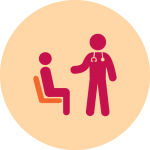Why Improving the Adolescent Experience of Reproductive Care Matters – And What to Do Next
Published on October 15, 2024

By Estelle Yeung, Colby Reed, Reshma Naik, Heather M. Marlow, Kate Sheahan, and Zachary Crosser
This blog is part of a series on patient experience of care. It highlights insights, reflections, and resources related to adolescent experience of care, building on a scoping review conducted by MOMENTUM Knowledge Accelerator. Visit the MOMENTUM website to read the other blogs and learn more about how insights from MOMENTUM’s experience of care work may apply to your work.
Adolescence is a time of rapid transformation, filled with unique challenges and opportunities. As young people navigate this critical phase of life, their experiences can impact their well-being and future health behaviors. Distinguishing and addressing the needs and preferences of this age group is essential for promoting their emotional, physical, and social health.
Why Focus on Experience of Care Among Adolescents?
Adolescence, defined by the World Health Organization as the period from ages 10–19, represents a unique phase bridging childhood and adulthood. Adolescents, especially those who are older, may rely less on parental involvement in their health care. Those who are sexually active, married, or even parents themselves may have specialized health care needs and unique barriers to meeting them. It is crucial for health systems to understand their circumstances and to make it easy for them to access high-quality maternal health care, reproductive health care, and voluntary family planning.¹
Adolescents’ first experiences discussing contraception and other reproductive health issues with providers will have a profound impact on their willingness and motivations to continue seeking care into adulthood. Thus it is essential for providers to build trust and to foster an overall positive experience of care with people in this age group.
Evidence shows that adolescents often feel that providers do not fully involve them in decisions related to their own care and do not provide them with information that they can easily understand. In fact, adolescents often fear that they’ll be stigmatized, treated poorly, or even have confidentiality broken by providers, who may judge them or have negative personal opinions about teen sexuality.² These challenges are often intensified in low- and middle-income countries (LMICs), where a lack of funding in health systems and fragmented service delivery exacerbate the disparities in experience of care compared to high-income countries (HICs).3 Developing tools to effectively address these barriers is essential to ensuring that adolescents receive the respectful, supportive, and confidential care they deserve.
While the World Health Organization’s patient-reported experience of care measures4 broadly define measures across age groups, their Standards for Improving the Quality of Care for Children and Young Adolescents provide additional considerations for adolescents, families, and caregivers.1 These standards recognize that the health care needs of adolescents are distinct from those of younger children and adults, and emphasize effective communication, respect for every adolescent’s rights, and the provision of educational, emotional, and psychosocial support tailored to their needs.
Comprehensively defining and measuring adolescent experience of care is paramount for improvements in health care quality efforts for adolescents. This approach can support health care services to effectively address the unique challenges adolescents face.5
Moving the Needle: Research From MOMENTUM
MOMENTUM Knowledge Accelerator conducted a scoping review to evaluate three key aspects of adolescent experience of care, in order to:6

Recognizing that much of the existing literature on adolescent experience of care has focused on care-seeking in HICs, MOMENTUM intentionally centered its review on LMICs.5 The scoping review revealed a significant gap in the measurement of adolescent experience of care, specifically in LMIC contexts.
The review ultimately identified the following five domains as most important for measuring adolescent experience of care in LMICs:
1. Accessibility
 Accessibility, including location and affordability, emerged as one of the most important factors influencing adolescent experience of care. Key barriers included long distances to health centers and lack of services in rural areas, as well as prohibitive costs for services, medication, family planning supplies, and transportation.
Accessibility, including location and affordability, emerged as one of the most important factors influencing adolescent experience of care. Key barriers included long distances to health centers and lack of services in rural areas, as well as prohibitive costs for services, medication, family planning supplies, and transportation.
2. Staff Attitudes
 Providers’ level of respect for adolescent patients was the most frequently cited characteristic within the staff attitude domain. The significance of having respectful, trustworthy, and friendly providers was underscored by adolescents’ fear of encountering providers who exhibited the opposite characteristics.5
Providers’ level of respect for adolescent patients was the most frequently cited characteristic within the staff attitude domain. The significance of having respectful, trustworthy, and friendly providers was underscored by adolescents’ fear of encountering providers who exhibited the opposite characteristics.5
3. Communication
 Although communication was a comparatively under-emphasized domain, adolescents noted a number of simple communication strategies that would make them more comfortable. For example, health care providers should offer friendly greetings, use warm facial expressions, and provide opportunities for patients to share their own opinions. Providers should also use accessible language when answering questions for adolescent patients, who may not have the same understanding of medical terms as adult patients.2
Although communication was a comparatively under-emphasized domain, adolescents noted a number of simple communication strategies that would make them more comfortable. For example, health care providers should offer friendly greetings, use warm facial expressions, and provide opportunities for patients to share their own opinions. Providers should also use accessible language when answering questions for adolescent patients, who may not have the same understanding of medical terms as adult patients.2
4. Care
 The care domain encompasses several key components, most notably, confidentiality and provider demographics. Adolescents said that it was important to have confidential interactions with providers and to be assured that the information they shared would not become known within their communities. They expressed fears about friends, neighbors, or community members overhearing conversations or providers even reporting back to their families; this was especially the case for those living with HIV who feared their status would be exposed and lead to stigmatization. In terms of provider demographics, adolescents felt most comfortable receiving care from younger providers of their same gender.
The care domain encompasses several key components, most notably, confidentiality and provider demographics. Adolescents said that it was important to have confidential interactions with providers and to be assured that the information they shared would not become known within their communities. They expressed fears about friends, neighbors, or community members overhearing conversations or providers even reporting back to their families; this was especially the case for those living with HIV who feared their status would be exposed and lead to stigmatization. In terms of provider demographics, adolescents felt most comfortable receiving care from younger providers of their same gender.
5. Environment
 Several components of the environment domain were identified as critical for adolescent experience of care. Inflexible appointment times and long wait times were barriers to accessing care. The physical environment where care is provided was also important for adolescents to have a positive experience. For adolescents, having a separate physical space to interact with providers and a private waiting area is key to protecting patient privacy and building trust.
Several components of the environment domain were identified as critical for adolescent experience of care. Inflexible appointment times and long wait times were barriers to accessing care. The physical environment where care is provided was also important for adolescents to have a positive experience. For adolescents, having a separate physical space to interact with providers and a private waiting area is key to protecting patient privacy and building trust.
What More Is Needed?
Across studies reviewed by MOMENTUM, definitions of adolescent experience of care were inconsistent, and there were limited articles found on measurement in LMICs.5 Existing literature on measuring adolescent experience of care did not include all of the five most relevant domains identified by MOMENTUM.7 Notably, domains related to provider demographics were not addressed by the literature. While MOMENTUM identified the accessibility, staff attitudes, communication, care, and environment domains as most important for measuring adolescent experience of care, there is currently no global, standardized tool to do so.
To improve the experience of adolescent health care, program implementers and measurement specialists should: define the components of adolescent experience of care in LMICs; refine conceptual frameworks for how experiences of care influence health outcomes; and streamline tools to measure adolescent experience of care in LMICs.6 This will equip researchers to measure adolescent experience of care in LMIC contexts using standardized measurement domains.
Reviewing age-appropriate domains for measuring adolescent experience of care in maternal and reproductive health is vital to address the distinct needs of this population compared to children and adults. It is crucial for health systems to address barriers to positive care experiences for this age group, as this will influence care-seeking for generations to come. Further research on adolescent experience of care in LMIC contexts will allow program implementers to address barriers to health equity in resource-limited settings.
To learn more about adolescent experience of care, check out these useful resources developed by MOMENTUM:
- Experience Matters: Improving the Quality of Health Care Through a Focus on Family and Child Perspectives (USAID MOMENTUM)
- Improving Metrics and Methods for Assessing Experience of Care Among Children and Caregivers in Low- and Middle-Income Countries (USAID MOMENTUM)
- Resource Guide for USAID Missions on Measurement of Self-Reported Experience of Care (EOC) Across RMNCA (USAID MOMENTUM)
- Equipping Private Health Providers to Meet the Contraceptive Needs of Young People in Nepal (USAID MOMENTUM)
- Meaningful Adolescent and Youth Engagement: Three Country Perspectives (USAID MOMENTUM)
- Partnering With Youth for Impact: Profiles of MOMENTUM Youth Partners From Across the Globe (USAID MOMENTUM)
References
- World Health Organization. (2018). Standards for improving the quality of care for children and young adolescents in health facilities.
- Byczkowski, T. L., Kollar, L. M., & Britto, M. T. (2010). Family experiences with outpatient care: Do adolescents and parents have the same perceptions? Journal of Adolescent Health, 47(1).
- World Health Organization . (2006). Quality of care: A process for making strategic choices in health systems.
- World Health Organization. (2022). Patient experiences in primary care: Patient questionnaire Version 0.2.7. Rapid telephone survey questionnaire for expert review and feedback.
- Ambresin, A.-E., Bennett, K., Patton, G. C., Sanci, L. A., & Sawyer, S. M. (2013). Assessment of youth-friendly health care: A systematic review of indicators drawn from young people’s perspectives. Journal of Adolescent Health, 52(6), 670–681.
- Afulani, P., Nakphong, M., & Sudhinaraset, M. (2023). Person‐centered sexual and reproductive health: A call for standardized measurement. Health Expectations, 26(4), 1–7.
- Marlow, H., Crosser, Z., & Sheahan, K. (2024). Adolescent experience of care in maternal health, reproductive health, and family planning: A scoping review. USAID MOMENTUM.

